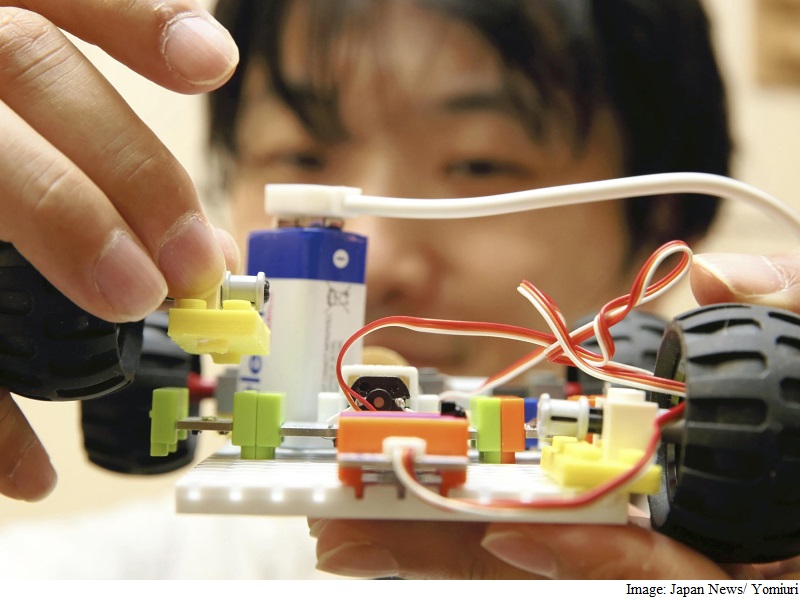Japan's 3D Printers Shape Dreams

It's well known that 3D printers can use data to manufacture a variety of three-dimensional objects. The technology has attracted attention for being able to create nearly anything and is being increasingly applied to industry, as well as research and development.
Recently, however, it seems that even company employees and housewives are utilizing 3D printers for a variety of needs.
"A gear in the washing nozzle of my toilet seat broke." "I want to fix the broken trigger on a high-pressure water hose." These are examples of the problems that customers bring every day to "Ah! 3D Printer Shop!!" in Nakano Ward, Tokyo.
One customer was Mieko Hiramatsu, 58, the manager of a condo in Tokyo's Koto Ward. She was dealing with old, cracked frames for elevator control buttons.
Hiramatsu contacted the elevator maker to try to get them repaired, but the needed parts were out of stock and replacing the entire control panel would cost more than JPY 300,000 (about $2,551). She tried to repair them with plastic clay bought at a JPY 100 shop, but was unsuccessful. She was stymied until she found the 3D printer shop on the Internet.
When Hiramatsu visited the Nakano shop, 35-year-old clerk Tsubasa Nakamura told her, "You can easily create the parts with a 3D printer."
After measurements were taken and the data input, the parts were printed out one after another. The total cost was JPY 4,000.
"After finishing the repairs, it works perfectly," said Hiramatsu "I couldn't believe the problem could be solved so easily."
In August last year, Japan's first competition for ideas utilizing 3D printers was held in Tokyo.
Keiko Ichinoki, 45, from Meguro Ward participated in the event with her idea to create custom nipples for baby bottles. A mother's nipple can be converted into data using a 3D camera to deal with "nipple confusion," in which babies dislike using bottles, or refuse to drink milk from their mother when they get too used to bottles.
Custom nipples can be printed out using a soft rubbery material and attached to bottles for use.
Ichinoki is raising three children. "Babies recognize their mother's nipples by their shape," she said. "And it occurred to me that if they [artificial nipples] are made in the same shape, babies shouldn't get confused."
The winner of the top prize was a project to develop supports for children's foot development, submitted by Prof. Kazuhiko Yamashita of Tokyo Healthcare University. Deformities in foot bones can be corrected by the use of insoles that improve a person's gait during childhood. The project aims to produce insoles that fit a child's feet.
The project has attracted JPY 1 million in investment from firms that sponsored the competition, and development to bring the project to fruition is under way.
Ichinoki has also received corporate support and is currently searching for a suitable material that is safe for infants.
Some people also use 3D printers for their hobbies. Seigo Tanaka, a 36-year-old company employee in Nakano Ward, enjoys making cars and buildings out of toy blocks. He wasn't satisfied just using the finished objects as decorations, and wanted to make them move and light up.
To achieve this, he created original parts to connect the blocks made by toy makers with electronic circuits. He was then able to create objects made out of blocks such as twinkling lighthouses and cars that could move like radio-controlled cars.
"I've created works that are one-of-a-kind," said a delighted Tanaka. "Why don't you give it a try and make something?" he asked me. I had trouble thinking of a good idea but decided to make a guard for a bamboo sword, inspired by my hobby of kendo.
I also decided to imprint my personal motto - "kokkishin" (self-control) - on the guard in kanji. Creating the data was easy, and it only took only about two hours to complete the guard. Even though it's a simple item, knowing that it was my original design made me happy.
According to Shinjiro Yamada, 66, an adviser for ICTCO, an incorporated association to vitalize industries in Nakano Ward, patents related to 3D printers are due to expire this year. This will lead to the sale of a variety of new models, he said.
3D printers have been abused in the past for illicit purposes such as manufacturing guns, but I realized that there can be many benefits when they are put to proper use.
Once the technology to combine artificial intelligence with 3D objects is created, it may be a good idea to create a body double of myself for my wife, who is often upset at me for always being away from home.
No comments:
Post a Comment